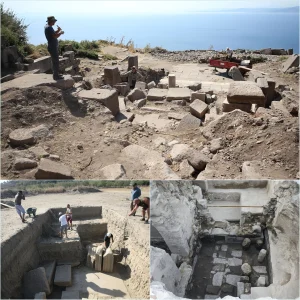
Archaeologists discovered the enormous granite sarcophagus of King Ramses II’s treasurer, Ptah-em-wia, at Saqqara, an ancient necropolis approximately 20 miles south of Cairo. The coffin’s surface was adorned with inscriptions honoring the late treasurer, aiding in his identification. These inscriptions, featuring symbols of protective deities such as the sky goddess Nut, emphasized Ptah-em-wia’s proximity to Ramses II.

The burial chamber and sarcophagus, undisturbed for millennia, offer potential insights into Egyptian governance following the era of King Tutankhamun, with Ramses II reigning around the 13th century B.C.E., a pivotal time in Egypt’s New Kingdom.

This significant find follows last year’s excavation of Ptah-em-wia’s tomb by Ola El Aguizy, emeritus professor of archaeology at Cairo University, and her team. Their exploration uncovered a vertical shaft in the tomb’s courtyard, leading to the discovery of the 26-foot sarcophagus after meticulous excavation. Such intact tombs are exceptionally rare due to historical looting and disturbances.
The ongoing discoveries at Saqqara also include a 4,300-year-old tomb belonging to an ancient Egyptian dignitary, highlighting the site’s rich archaeological potential. National Geographic has documented these excavations as part of its comprehensive series, “Lost Treasures of Egypt,” offering a glimpse into the meticulous work and significant findings reshaping our understanding of ancient Egyptian history.





